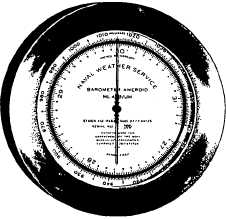ADDITIONAL WEATHER-RELATED
RESPONSIBILITIES.—In addition to the assistance
you may provide during heavy weather, you will have
other POOW responsibilities concerning weather.
Some of those responsibilities are the measuring of
temperature, atmospheric pressure, and wind speed.
You also must have a working knowledge concerning
weather flags and pennants.
Measuring Temperature.—You probably don’t
need to be told that a thermometer is an instrument for
measuring temperature. The ship’s thermometer is
usually located on the bridge, but on some small ships
it is located near the quarterdeck area. Most Navy
thermometers are liquid-filled and practically all of
them use the Fahrenheit (F) scale which is based on the
freezing point of water being 32F and the boiling
point being 212F.
A thermometer must be read properly for you to
obtain an accurate result. First, if you must handle it, be
sure that you do not touch the lower part of the glass
containing the liquid. The heat from your body can
affect the height of the liquid column and give an
erroneous temperature reading. Make sure that the top
of the column is level with your eyes; otherwise, you
will be reading a higher or lower graduation than the
one actually indicated.
Another weather device that you must use to
forecast the approach of a storm is the barometer.
Measuring Barometric Pressure.—The aneroid
barometer, as shown in figure 8-2, contains a small
metallic cell, called a Sylphon cell, which encloses a
partial vacuum. As atmospheric pressure increases, the
Sylphon cell contracts; as pressure decreases, it
expands. As the Sylphon cell expands and contracts, it
communicates motion to an indicating pointer on a
graduated scale.
The aneroid barometer can be read in inches of
mercury and in millibars (mb). Both inches and
millibars are measurements of the weight of the
atmosphere at a given time and point. The average
atmospheric pressure at sea level is 29.92 inches or
1,013.2 millibars. Figure 8-3 shows the comparative
readings on the inch and millibar scales.
The aneroid barometer normally can be read no
closer than 0.01 inch. Aneroid barometers are the
standard pressure-indicating instrument aboard ship
and the type of barometer that the POOW will
encounter most frequently. Barometers are normally
checked (calibrated) yearly by the quartermaster
division, following the preventive maintenance system
(PMS) procedures. Another important forecasting tool
is the wind speed and direction indicator.
Measuring Wind Speed and Direction.—An
installed anemometer is shown in figure 8-4. It is an
instrument fixed somewhere aloft, usually at the
masthead of the ship. The wind blows on a propeller
attached to one end of a wind vane that pivots. The
whirling propeller revolves a spindle, communicating
with a synchro repeater on the pilothouse or chart
house bulkhead. Figure 8-5 shows one type of synchro
repeater.
8-16
MRP3F0502
Figure 8-2. Aneroid barometer.
1050
1047
1044
1041
1038
1035
1032
1029
1026
1023
1020
1017
1014
1011
1008
1005
1002
999
996
993
990
987
984
981
978
975
972
969
966
963
960
957
954
951
948
31.0
30.9
30.8
30.7
30.6
30.5
30.4
30.3
30.2
30.1
30.0
29.9
29.8
29.7
29.6
29.5
29.4
29.3
29.2
29.1
29.0
28.9
28.8
28.7
28.6
28.5
28.4
28.3
28.2
28.1
28.0
1013 MILLIBARS
OR
29.92 INCHES
AT SEA LEVEL
MRP3F0503
Figure 8-3. Inches and millibars.




